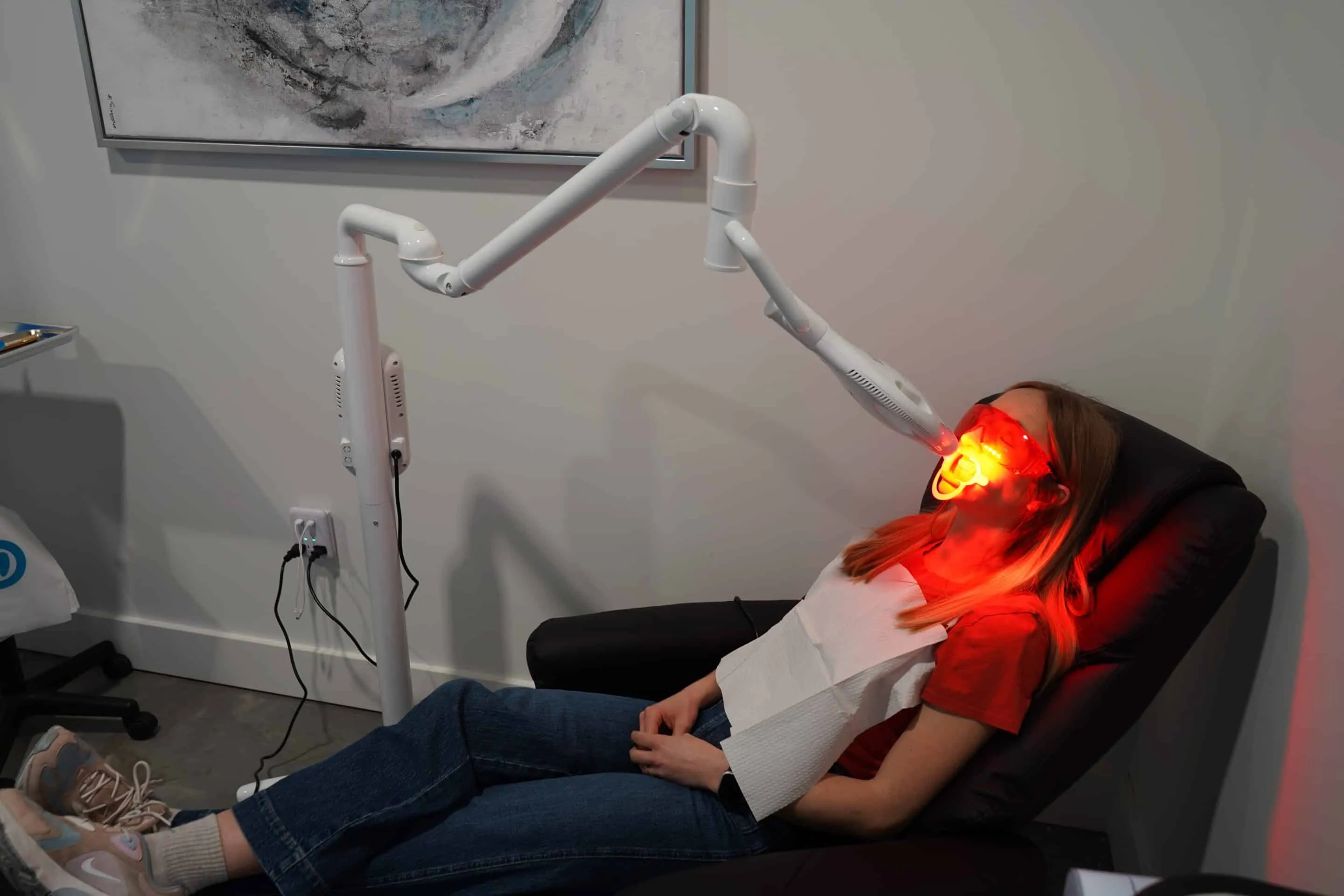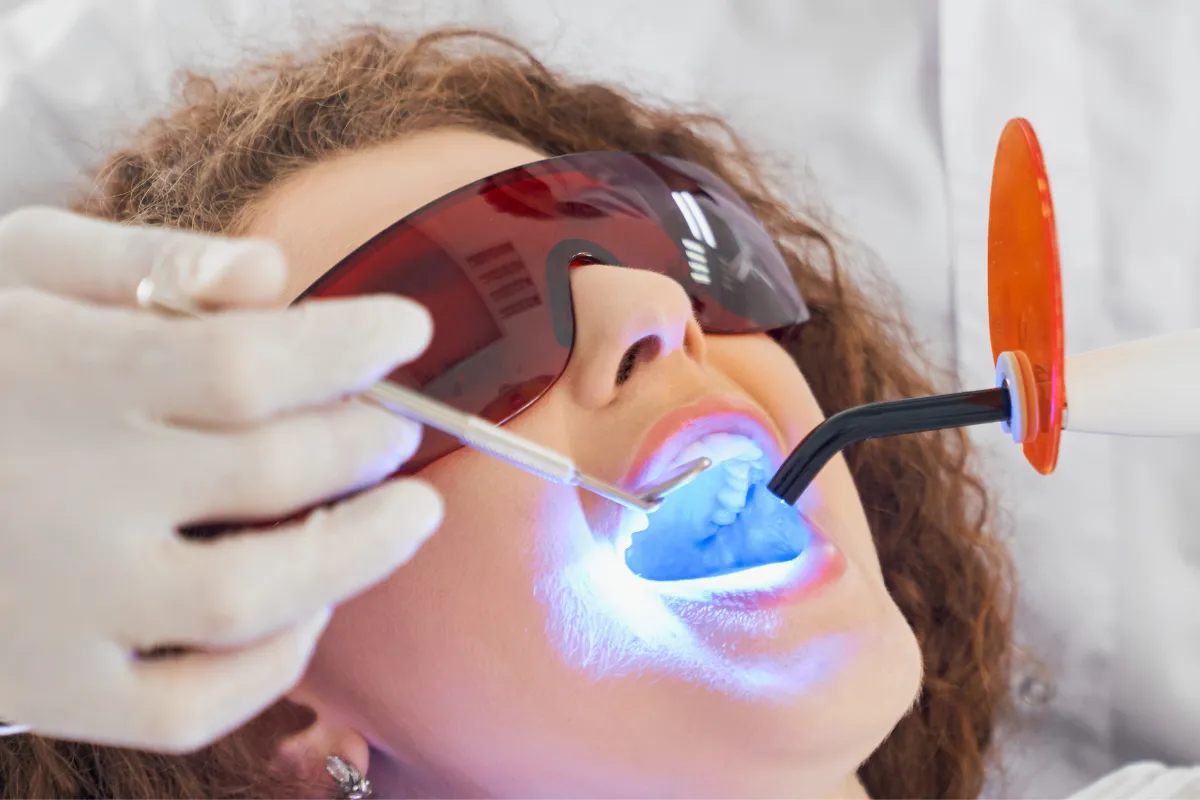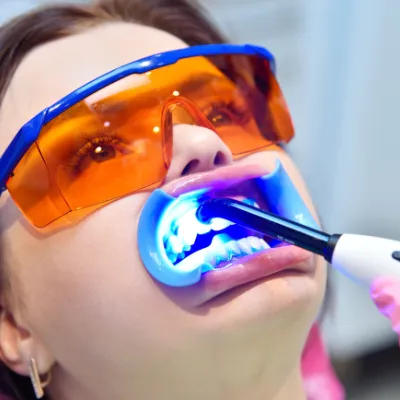What is Laser Whitening
Laser whitening, also known as power whitening, is a popular cosmetic dentistry procedure designed to brighten and enhance the color of your teeth. It utilizes a high-intensity laser light to accelerate the effects of a bleaching agent, typically hydrogen peroxide. This process can significantly lighten teeth in a single session, offering a quick and effective solution for those looking to improve their smile. The procedure is generally performed by a dental professional in a controlled clinical setting, ensuring safety and optimal results. Laser whitening is particularly effective at removing stains caused by coffee, tea, tobacco, and aging, leaving patients with a noticeably whiter and more radiant smile. This method has gained popularity because of its ability to deliver dramatic results in a relatively short amount of time, making it a convenient option for people with busy schedules.
The Science Behind Laser Whitening
The science behind laser whitening involves a chemical reaction triggered by the laser light. The process begins with the application of a bleaching agent, usually a high-concentration hydrogen peroxide gel, to the surface of the teeth. This gel penetrates the enamel and dentin, the layers beneath the enamel, where stains and discoloration reside. The laser light acts as a catalyst, speeding up the breakdown of the hydrogen peroxide, which then releases oxygen molecules. These oxygen molecules oxidize the stain molecules, breaking them down and effectively lightening the teeth. The laser itself doesn’t directly whiten the teeth, but it significantly accelerates the process, making it more efficient and enhancing the final results. The wavelength of the laser is carefully selected to maximize the activation of the bleaching agent while minimizing any potential damage to the tooth structure or surrounding soft tissues.
How Laser Whitening Works

Laser whitening works through a carefully orchestrated process involving a bleaching agent and a high-intensity laser. The initial step involves a thorough dental examination and cleaning to ensure the teeth are free of plaque and tartar, which can hinder the bleaching process. Next, a protective barrier is applied to the gums and soft tissues to prevent irritation from the bleaching agent. The bleaching gel, typically containing a high concentration of hydrogen peroxide, is then carefully applied to the surface of the teeth. The laser is directed at the teeth, and the light energy activates the bleaching agent, causing it to break down stains and discolorations. This process is repeated several times during a single session, with the dentist monitoring the progress and adjusting the treatment as needed to achieve the desired level of whitening. The entire procedure usually takes about an hour to complete, offering a convenient option for patients seeking immediate results.
The Role of Hydrogen Peroxide
Hydrogen peroxide is the active ingredient in most teeth-whitening treatments, playing a crucial role in laser whitening. The concentration of hydrogen peroxide varies depending on the treatment, with professional laser whitening using a higher concentration than at-home kits. The hydrogen peroxide gel, when applied to the teeth, penetrates the enamel and dentin layers, where it interacts with the stain molecules. The laser light doesn’t directly whiten the teeth, but its energy accelerates the chemical reaction of hydrogen peroxide. As the hydrogen peroxide breaks down, it releases oxygen molecules. These oxygen molecules are the workhorses of the whitening process; they oxidize the stain molecules, breaking them down and effectively lightening the teeth. The effectiveness of the whitening process depends not only on the concentration of hydrogen peroxide but also on the duration of its contact with the teeth and the presence of the laser light.
The Laser’s Activation Process
The laser’s role in laser whitening is to accelerate the bleaching process. The laser emits a specific wavelength of light that is absorbed by the hydrogen peroxide gel. This absorption creates heat, which speeds up the chemical reaction and enhances the release of oxygen molecules. This acceleration leads to faster and more effective stain removal. The laser’s energy also helps to increase the penetration of the bleaching agent into the enamel and dentin, allowing it to reach deeper stains. The dentist carefully controls the laser’s intensity and duration to ensure the best results while minimizing potential side effects such as tooth sensitivity. The activation process is precise and controlled, ensuring the hydrogen peroxide’s effectiveness and optimizing the overall whitening outcome. This targeted approach makes laser whitening a highly efficient method for achieving a brighter smile.
Top 5 Facts About Laser Whitening

Fact 1 Quick Results
Laser whitening offers the benefit of quick results. A single session, usually lasting about an hour, can significantly lighten your teeth, often by several shades. This makes it a convenient option for individuals who want to see immediate improvements in their smile. The rapid results are due to the laser’s ability to accelerate the bleaching process. While the exact results can vary based on the initial tooth shade and the type of stains, many patients experience a noticeable difference immediately after the procedure. This quick turnaround is one of the main reasons laser whitening is a popular choice for special events, such as weddings or important meetings, where a bright smile is desired.
Fact 2 Minimal Discomfort
While some individuals may experience mild sensitivity, laser whitening is generally associated with minimal discomfort. The procedure is non-invasive, and the dental professional takes steps to minimize potential irritation. Protective measures, such as isolating the gums and soft tissues, help prevent any direct contact with the bleaching agent. The laser itself doesn’t cause pain; any discomfort is typically due to the sensitivity of the teeth. The dentist can apply desensitizing agents before or after the procedure to alleviate sensitivity. Most patients find the experience to be relatively comfortable, making laser whitening a well-tolerated option for achieving a brighter smile. Any discomfort is usually temporary and subsides shortly after the treatment.
Fact 3 Professional Supervision

Laser whitening is performed under the supervision of a dental professional. This ensures the safety and effectiveness of the procedure. Dentists and trained professionals have the expertise and equipment to assess your oral health, determine if laser whitening is appropriate for you, and administer the treatment safely. They can monitor your progress, adjust the treatment as needed, and address any potential issues. Professional supervision minimizes the risk of complications, such as gum irritation or excessive sensitivity. The dentist will also provide aftercare instructions to maintain your results and protect your teeth. This professional oversight provides peace of mind and guarantees that the laser whitening procedure is performed with the highest standards of care.
Fact 4 Enhanced Whitening
Laser whitening often provides enhanced whitening results compared to at-home methods. The combination of a high-concentration bleaching agent and the laser’s activation leads to a more significant color change in a shorter time. Laser whitening can effectively address a wider range of stains, including those caused by aging, coffee, tea, and tobacco. The laser helps to penetrate the enamel and dentin, targeting deeper stains that may not respond to other whitening treatments. The ability to achieve dramatic results in a single session is a major advantage of laser whitening. The professional-grade treatments and the precise application of the laser lead to a brighter, more radiant smile.
Fact 5 Long-Lasting Effects
While laser whitening is not permanent, the effects can be long-lasting with proper care. The results can typically last from several months to a few years, depending on your lifestyle and habits. To maintain the whitening effects, it’s important to avoid or limit the consumption of staining foods and drinks, such as coffee, tea, red wine, and dark-colored berries. Good oral hygiene practices, including regular brushing, flossing, and dental checkups, also play a crucial role in preserving your results. Your dentist might recommend touch-up treatments or at-home whitening products to extend the longevity of your brighter smile. With proper care, the effects of laser whitening can be enjoyed for an extended period, allowing you to maintain a confident and beautiful smile.
Who is a Good Candidate for Laser Whitening

Good candidates for laser whitening typically have healthy teeth and gums and are looking to improve the appearance of their smile. Individuals with stains caused by coffee, tea, tobacco, or aging are often excellent candidates, as laser whitening is very effective at removing these types of discoloration. However, it’s essential to consult with a dentist to determine if laser whitening is the right choice for you. The dentist will assess your oral health, check for any existing dental problems, and discuss your expectations and goals. Laser whitening may not be suitable for everyone; for example, it’s not recommended for pregnant or breastfeeding women. Additionally, individuals with sensitive teeth or certain dental conditions may require alternative whitening methods. The best candidates are those who are committed to good oral hygiene and are realistic about the results. After a thorough evaluation, the dentist can determine if you are a good candidate and discuss the procedure in detail.
The Laser Whitening Procedure
Before the Procedure
Before undergoing laser whitening, you’ll have a consultation with your dentist. This is a crucial step to assess your oral health and determine if you are a suitable candidate. The dentist will conduct a thorough examination of your teeth and gums, looking for any signs of cavities, gum disease, or other dental issues. They will also discuss your expectations and goals for the whitening treatment. If any dental problems are detected, they will need to be addressed before proceeding with the whitening procedure. You’ll also receive instructions on what to expect during the procedure, any necessary preparations, and aftercare instructions. The dentist may also take photographs of your teeth before the treatment to track the progress. This comprehensive preparation ensures the safety and effectiveness of the laser whitening procedure, allowing the dentist to tailor the treatment to your specific needs.
During the Procedure

During the laser whitening procedure, the dental professional will take several steps to ensure your comfort and safety. First, your teeth will be thoroughly cleaned to remove any surface stains and plaque. A cheek retractor is placed to keep your mouth open and provide access to your teeth. Protective measures are then taken to shield your gums and soft tissues from the bleaching agent, usually involving the application of a protective gel or barrier. The dentist will then apply the whitening gel to your teeth. The laser light is then directed at the teeth, activating the bleaching agent. This process is repeated multiple times, typically for 15-20 minutes per session, depending on the desired results. The dentist will monitor the progress and may adjust the treatment as needed. During the procedure, you may feel a slight tingling sensation, but discomfort is typically minimal. The entire procedure usually takes about an hour to complete, offering a relatively quick path to a brighter smile.
After the Procedure
After the laser whitening procedure, your dentist will provide you with post-treatment instructions. You may experience some tooth sensitivity, which is a common side effect and usually subsides within a few days. Your dentist may recommend using a desensitizing toothpaste to help manage this. It’s essential to follow a specific diet immediately after the treatment, avoiding highly pigmented foods and drinks, such as coffee, tea, red wine, and dark-colored berries, for the first 24 to 48 hours. You’ll also need to maintain good oral hygiene practices, including brushing your teeth gently with a soft-bristled toothbrush and flossing regularly. Your dentist may also recommend touch-up treatments or at-home whitening products to maintain your results. Following these aftercare instructions helps to ensure your comfort, protect your teeth, and maximize the longevity of your brighter smile. Regular check-ups with your dentist are also important to monitor the results and address any concerns.
Potential Side Effects
While laser whitening is generally safe, it’s essential to be aware of potential side effects. The most common side effect is tooth sensitivity, which can range from mild to moderate and usually subsides within a few days. Some individuals may also experience gum irritation, which is usually temporary. Other potential side effects include slight changes in the enamel, although these are usually minimal and temporary. It is rare, but there is a slight possibility of irritation to the throat or soft tissues if the protective measures are not properly in place. Before undergoing laser whitening, your dentist will discuss these potential side effects with you and take precautions to minimize the risks. Following the post-treatment instructions carefully, including using desensitizing toothpaste and avoiding staining foods and drinks, can help manage any side effects and ensure a comfortable experience.
